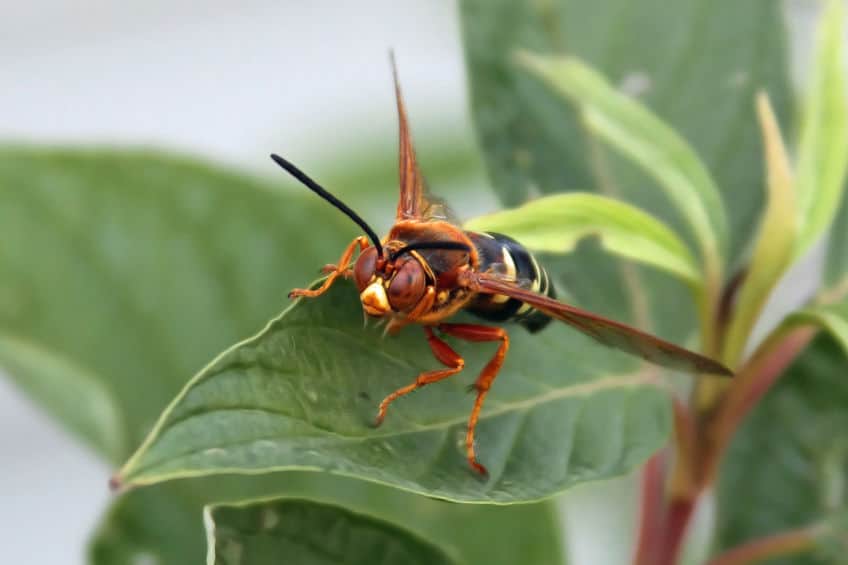The eastern cicada killer wasp, Sphecius speciosus, also known as the cicada hawk and sometimes erroneously giant ground hornets. They are solitary wasps found across America. It is a type of digger wasp.
How big are cicada killer wasps and is the sting painful?
Cicada killers are up to 2 inches (5 cm) long. Of all wasp species, this puts them right up there for size. Often because of this size, they can be mistaken for murder hornets, but unlike murder hornets, these wasps are gentle giants and live solitary lives. They need to be big in order to move their cicada prey. The sting of the cicada ranks a relatively low 1.5 out of 4 on the Schmidt insect pain index despite their large size. Check out which wasps have the most painful stings here.
How did the cicada killer wasp get its name?
They paralyze cicadas and give them to their larvae to kill. Cicada killer wasps do not kill cicadas themselves. Rather they paralyze them and place them in their burrows to provide food for the developing wasp larvae. The wasp larvae will then gradually consume the paralyzed cicadas, gradually killing them. The female will lay an egg in her burrow, provide the cicadas, and then seal the burrow. She will not return to the burrow once the egg is laid and cicadas left.

Do cicada killers make nests?
They make burrows up to 10 inches (25 cm deep). Here the female cicada killer wasp will lay her eggs and provide paralyzed cicadas for her offspring to consume. They have specially developed front legs to help them to dig in the sand. The front legs have large spines that help them to dig, known as calcaria.
Can cicada killers hear?
There is no evidence they can hear. Wasps do not have ears as mammals do, rather they sense the world through their antennae and there is no evidence they can hear sounds. The very loud noise made by cicadas is, therefore, perhaps not a factor for the cicada killer wasp. Cicadas can make sound levels of 105 decimals, thankfully much of it outside the range of our own hearing. This is actually deployed as a defense against some predators but the cicada wasp is not perturbed by this high pitch sound.
Do cicada killers prey on large cicadas?
They can fly carrying cicadas 1.5 times larger than their own body weight. After paralyzing a cicada with their sting they must transport it to their burrows in order to provide the necessary food for their offspring. This can be tricky given that despite their large size cicadas are often bigger than they are. Large cicadas also offer more food for the wasp offspring so are desirable.
Female cicada killers are able to fly with these heavy burdens, but only so far. They never nest too far from where they hunt (around 100 meters) making a steady downward trajectory towards their burrows. This burden can make them vulnerable. Kingbirds for example target wasps only when carrying cicadas and actually steal the cicadas from the wasp.
Do male cicada killers do the hunting?
Only female cicada killer wasps dig and hunt. Female cicada killers, as with most wasp species, do all the heavy lifting. They dig their burrows single-handedly and do all of the hunting. In fact, the only role left for the males is to mate with the females. They will live only a few weeks compared to the few months the females live.
They can decide if their offspring will be male or female. Like other wasp species, the female stores sperm from the male in her body and does not fertilize an egg until the time of her choosing. If she decides not to fertilize an egg then that wasp will be a male. Fertilized eggs will become female.
Is there a big difference between male and female cicada killers?
Males are half the size of females and can’t sting. As the males don’t hunt or dig, size really isn’t so important to them. For this reason, they will be given less food when developing and so grow smaller. Males are usually given one cicada and females two. As with all wasps, only females can sting. This is because the stinger is actually part of the reproductive organ.
Do cicada killer wasps fight each other?
Males duel each other for the right to mate. There are about twice as many males cicada killers as females and as such, they compete with each other for the chance to mate. They will claim territory and fight each other for the right to it. This often results in duels between the male wasps. They will grapple and bite each other.
How do male cicada killers know which females to inseminate?
Virgin females fly differently to females that have mated. A mated cicada killer flies in zig zags whereas an unmated wasp will fly in a straight line. Male cicada killers can pick up on this so avoiding the problem of males constantly trying to inseminate the same wasp multiple times. Males will chase virgin wasps and attempt to mate with them. The mating usually takes about an hour.
(Source: Justin Schmidt – The Sting Factor)
